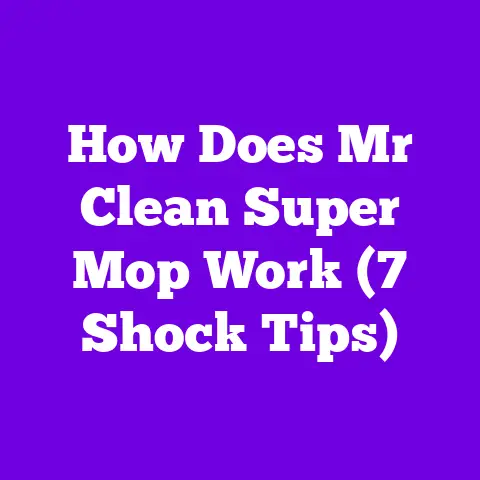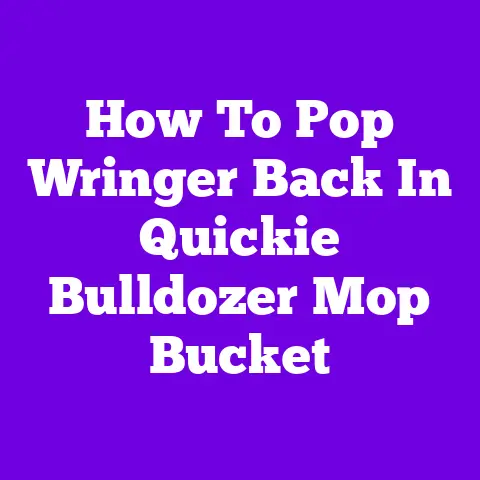How To Clean Shark Steam Mop Head (2 Easy Methods)
To clean a Shark steam mop head, you can use two methods: Method 1 involves soaking the mop head in a vinegar solution for an hour, rinsing it, and letting it air dry. Method 2 requires machine-washing the mop head separately without fabric softeners or bleach, and then air or low-heat drying it. Regular cleaning is vital for maintaining the mop’s effectiveness, and you can choose either method based on your preference.

Shark steam mops are one of the easiest ways to get a sparkling floor. However, when is the last time you gave it a closer look?
When did you last clean it? Have you noticed your mop doesn’t seem to build up as much steam anymore?
Every Shark steam mop comes with a quick and easy-to-use head cleaning and renewing system.
The Shark Steam Pads and Tank Systems feature a disposable head attachment that slides onto the telescopic handle of your Shark Steam Mop.
Simply fill your tank with water, attach the pad to the head, and start steaming away.
When you’re done cleaning, just dispose of the head attachment and start over for a new clean pad next time!
Key Takeaways
- Regularly cleaning the mop head ensures sparkling clean floors and improves overall performance.
- Cleaning the mop head after each use and at least once a week prevents bacteria buildup and extends the lifespan of the steam mop.
- Thoroughly cleaning the mop head and preventing clogs increases steam efficiency and removes dirt and grime effectively.
- Proper maintenance, including rinsing the mop head regularly, inspecting for debris, and following manufacturer’s instructions, ensures continuous steam production and saves time and effort.
What Are Hard water scales in Shark steam Mop?
That pesky hard residue is never a pretty view. It can be frustrating to see after you had just cleaned three days ago.
It’s even worse when you find it hard to clean spots like the inside of your shark steam mop.

Hard water scales are from a multitude of minerals in your water. Calcium and magnesium are the main ones that circulate in the water.
When the water is heated, like by your steam mop, the minerals then combine and leave the hard water scales behind.
Causing you to throw your hands up in frustration. Hard water scales will damage your steam mop and reduce its usable life drastically.
The hard water will not only leave the mineral deposits in the water tank for you to see but in the hoses as well.
The hoses are harder to see and clean out compared to the tank.
The hoses could eventually have so much build-up they don’t flush the water out correctly. The filters will also clog up.
Causing you to change them more than what should be necessary.
The minerals will lead to damaging the steam mops boiler as well.
You can buy a replacement tank relatively affordably, the boiler, on the other hand, is a different story.
Are you still unsure if your steam mop has a hard water build-up?
Take a look at your mop, and check the corners where water tends to not drain. Does it have a “foggy look”, if so then that is your culprit.
If you use traditional mops instead of steam mop, you may not get the best cleaning result but you can re-use or recycle the mops when it is old.
Where to Begin?
Running the steam mop with distilled or di-mineralized water is the best water to use.
That can become a pricy option depending on how often you use your steam mop.
Tap water is the quick go-to and usually an okay option. However, with any water that you use. Maintenance cleaning will be necessary.
Two Methods of Cleaning
- Unplug your steam mop and make sure it is 100% cooled off. If your mop is still warm it could cause you to get burnt. Water and electricity never mix.
- If it is possible for your mop model, take out the water tank. There are de-scaler products you can purchase at the grocery or home store. But a quick home remedy is 1 ½ ounce baking soda with one quart of clean distilled water.
- Allow your mop to warm up and stay heated for 1 to 2 hours.
- Then allow the tank to cool down completely. Before step number 5.
- Drain your unit. Try to ensure all the water is out of the tank before reassembly.
Vinegar and Water
The steps are similar; vinegar may be a good secondary cleaner if the first mixture doesn’t wash away all the hard scales away.
Vinegar is a natural antimicrobial. With vinegar being an acid, it will cut through the buildup throughout your mop.
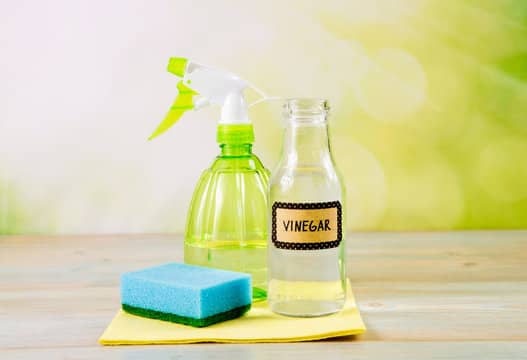
- unplug your steam mop
- Add in a solution of 2 parts water and 1-part vinegar. Some people who are sensitive to the vinegar smell may want a more diluted mixture.
- Let the mixture sit for an hour. This gives the vinegar a chance to clean the tank and hoses
- You can then heat your unit on the highest setting for at least an hour or however long you can handle the vinegar smell.
- Drain the tank after it has cooled.
Preventing Hard Water Scales
Cleaning out the hard water scales is one part of the problem. Preventing them is a way to cut down your cleaning time along with extending the life of your mop.
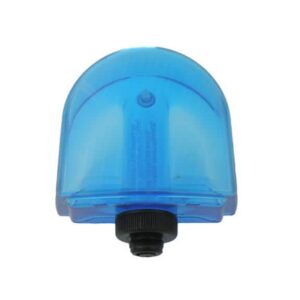
Always drain your tank after each use. If your steam mop allows you to remove the tank you can wipe the excess water out to have a dry tank.
Be leery of scrubbing your tank with any abrasive fabrics. This will damage the plastic tank. Once the plastic is scratched it will be more prone to stains.
The scratch marks will also be harder to clean next time.
What Not to Do
Some may think this is the last straw hearing about how their hard water is causing more problems. Hard water can plague you in many ways.
That it is time for a water softener to alleviate themselves from these problems.
Unfortunately, after the water goes through the softening system it will contain salt, another mineral. This will damage your steam mop’s boiler.
Distilled water will be the best option for your mop.
Other Tips to Ward off Hard Water Scales
Try allowing your tank to completely dry after using it. Wipe it down the best that you can and then leave it out to air dry. Do not use commercial cleaners in your steam mop.
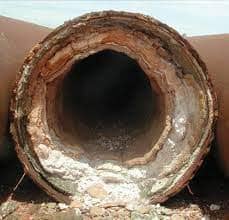
Commercial cleaners could break down the gaskets in your mop. Never leave water sitting in your tank even for a day. The water will leave a residue for sure. It could also cause mold.
Which is even harder to clean than hard water scales?
Clean your mop every couple of months. Use this time to inspect the tank along with the hoses if you have that option.
Some mop heads are hard when they are new. You can soften the mop head if needed.
5 Things You Should Consider While Taking Apart Shark Steam Mop
When taking apart your Shark steam mop, there are a few key points to consider.
First, make sure you dismantle the mop properly to avoid any damage.
Next, be sure to clean the mop pads thoroughly after each use to remove any dirt or debris.
Lastly, regularly replace the mop pads to ensure optimal cleaning performance.
Additionally, don’t forget to clean the mop head itself and descale it periodically to keep it in top condition.
Dismantling the mop
To dismantle the mop head, you’ll need to unscrew the fasteners on the bottom. Here are the steps to follow:
- Start by unplugging your Shark Steam Mop and ensuring that it has completely cooled down.
- Locate the fasteners on the bottom of the mop head and use a screwdriver to unscrew them.
- Once all fasteners are removed, carefully lift off the mop head from the main body of the steam cleaner.
- After removing the mop head, you can detach the steam mop pads for cleaning or replacement.
Remember to empty and clean out any remaining water in the removable water tank before starting this process.
Additionally, avoid using harsh cleaning solutions on your shark steam mop as they may damage its components.
By following these simple steps, you can easily dismantle your shark steam mop head for thorough cleaning or maintenance purposes.
Cleaning the mop pads
After dismantling the mop, it’s important to take care of cleaning the mop pads.
Start by rinsing them with hot water to remove any loose dirt or debris.
Then, fill a sink or bucket with warm water and add a small amount of liquid detergent.
Submerge the shark steam mop pads in the soapy water and agitate them gently to release any trapped dirt.
After a few minutes, rinse the pads thoroughly with clean water to remove any soap residue.
Squeeze out excess water and let them air dry completely before reattaching them to the steam mop head.
Following these simple steps will ensure that your shark steam mop pads stay clean and in proper condition for effective cleaning every time you use your steam mop.
Replacing mop pads
To keep the mop pads in good condition, regularly replacing them is necessary. When you notice that your mop pad is no longer effective or has become too dirty to clean with, it’s time for a replacement. Replacing the mop pads on your Shark steam mop is a simple process that will ensure you continue to have clean floors. Here’s how you can do it:
- Start by unplugging your steam mop and letting it cool down.
- Remove the dirty mop head from the steam mop.
- Fill a tank with water, preferably distilled water, and add a cup of vinegar to create a vinegar solution.
- Place the new mop pad onto the steam head and secure it properly.
- Plug in your steam mop and allow it to heat up.
- Once heated, start cleaning your floors using hot steam and the vinegar solution.
Regularly replacing your mop pads will ensure effective everyday cleaning without relying on commercial cleaners.
Cleaning the mop head
Maintaining the mop head is essential for effective cleaning. To clean the shark steam mop head, start by unplugging the mop and allowing it to cool down completely.
Remove the mop pad by detaching it from the mop head. For light cleaning, create a water solution by mixing equal parts of water and white vinegar in a spray bottle. Spray this solution onto the mop pad and use a damp cloth to wipe away any dirt or residue.
If there are stubborn stains or build-up on the mop head, remove it from the mop handle and soak it in warm soapy water for about 15 minutes. Use a nozzle cleaner to unclog any debris from the control panel or filling flask.
Once cleaned, reattach the mop head onto the mop handle and set it to its lowest setting before using it again for optimal performance on your tile floor.
Descaling and decalcifying
To continue cleaning the mop head, it’s important to tackle another important step: descaling and decalcifying. This is crucial for maintaining the efficiency of your Shark steam mop head.
Start by mixing equal parts of fabric softener and laundry detergent in a bowl filled with cold water. Dip a cotton pad into this solution and gently rub it across the surface of the mop head to remove any mineral deposits or buildup. Remember, avoid using harsh chemicals that could damage the mop head.
To help you visualize this process, here’s a handy unordered list:
- Mix fabric softener and laundry detergent in cold water
- Soak a cotton pad in the solution
- Gently rub the damp cotton pad on the mop head
- Continue until all stubborn stains and mineral deposits are removed
By following these steps, you’ll ensure your Shark steam mop head stays clean and ready for use!
Can I Repair A Clogged Shark Steam Mop At Home?
You can easily repair a clogged Shark steam mop at home. If you notice that your mop is not producing steam or the flow is weak, it could be due to a clog in the mop head.
To fix this, start by unplugging the mop and allowing it to cool down completely. Next, detach the mop head from the handle and rinse it under warm water to remove any loose dirt or debris. Use a gentle cycle on your washing machine or hand wash with mild soap if necessary. Avoid using scented perfumes or harsh chemicals as they can damage the mop head.
If there are stubborn clogs, gently insert paper clips into the steam nozzles to dislodge any blockages, being careful not to apply too much force or risk electric shock. Once cleaned and unclogged, reattach the mop head securely before plugging it back into a power outlet.
It’s important to note that attempting repairs during the warranty period may void your warranty, so always check with Shark for guidance first.
Can The Shark Steam Mop Disassembly Process Be Dangerous?
Disassembling the Shark steam mop can be hazardous if not done carefully. It is important to take precautions to ensure your safety during the disassembly process.
First, make sure that the mop is unplugged and turned off before you begin. Then, wear protective gloves to prevent any injuries while handling the parts.
Carefully follow the manufacturer’s instructions for disassembling the mop, making sure to remove all screws and detachable components with caution. Avoid using excessive force or prying tools that may cause damage or injury.
Take note of how each part is connected so you can easily reassemble it later. Lastly, store all small pieces in a safe place to avoid losing them and causing potential hazards in the future.
Cleaning Nozzle and Head
After disassembling the Shark steam mop, it is important to clean the nozzle and head. This will ensure that your mop continues to work effectively and efficiently. Cleaning the nozzle and head is a simple process that can be done in just a few steps. Firstly, remove any excess dirt or debris from the nozzle and head using a soft brush or cloth. Next, fill a sink or bucket with warm water and add a small amount of mild detergent. Place the nozzle and head into the soapy water and let them soak for about 10 minutes. After soaking, use a soft brush to gently scrub away any remaining dirt or grime. Rinse thoroughly with clean water and allow them to air dry before reassembling your steam mop.
| Steps | Description |
|---|---|
| 1 | Remove excess dirt from nozzle and head |
| 2 | Soak in warm soapy water for 10 minutes |
| 3 | Gently scrub away dirt with soft brush |
| 4 | Rinse thoroughly with clean water |
| 5 | Air dry before reassembling |
By following these simple steps, you can keep your Shark steam mop in top condition and ensure that it continues to provide you with effective cleaning power.
Tips and Techniques
For optimal results, try using different techniques and tips when using your Shark steam mop. Here are three key tips to keep in mind:
- Pre-treat tough stains: If you’re dealing with stubborn stains or sticky residue, it’s a good idea to pre-treat the area before using your steam mop. You can use a mild detergent or vinegar solution to loosen the grime, then follow up with the steam mop for a thorough clean.
- Use distilled water: To prevent mineral build-up and ensure efficient performance of your Shark steam mop, always use distilled water instead of tap water. This will help prolong the life of your mop and maintain its effectiveness over time.
- Clean the mop head regularly: After each use, take a few minutes to clean the mop head thoroughly. Rinse it under warm water and remove any debris or fibers that may have accumulated during cleaning. This will help prevent clogs and maintain optimal steam production.
By following these simple tips, you can ensure that your Shark steam mop continues to deliver sparkling clean floors every time you use it!
Conclusion
In conclusion, maintaining a squeaky clean shark steam mop head is simple and satisfying.
By following the tips and techniques mentioned above, you can effortlessly disassemble the mop and clean its nozzle with ease.
Remember to be cautious while handling hot water and always prioritize safety.
With a little patience and practice, you’ll become a pro at keeping your shark steam mop in tip-top shape.
So go ahead, give it a whirl and watch those dirt demons disappear!

